Oldsmobile Starfire
The Oldsmobile Starfire is an automobile nameplate used by Oldsmobile, produced in three non-contiguous generations beginning in 1954. The Starfire nameplate made its debut with the 1954–1956 Ninety-Eight series convertibles. For 1957 only, all Ninety-Eight series models were named "Starfire 98".[1]
| Oldsmobile Starfire | |
|---|---|
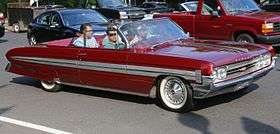 1961 Oldsmobile Starfire convertible | |
| Overview | |
| Manufacturer | General Motors |
| Production | 1960–1966 1974–1980 |
| Body and chassis | |
| Class | Full-size (1961–1966) Subcompact (1975–1980) |
After a two-year hiatus the Starfire name returned for 1961 as separate model offered in a single convertible body style. Intended to compete in the growing personal luxury car market, from 1961 to 1965 the Starfire Convertible was the highest-priced model offered by Oldsmobile. While it shared most of its sheet metal with other full-sized Oldsmobile models, the Starfire wore unique trim and luxurious interiors. The Starfire Coupe hardtop joined the convertible for the 1962 model year. For the final 1966 model year, the convertible was dropped and the Starfire was moved downmarket to make room for the all-new Oldsmobile Toronado.
After a nine-year break, the Starfire nameplate returned for the 1975 model year as Oldsmobile's first subcompact, powered by a Buick V6 engine. The 1977 Starfire featured the first-ever Oldsmobile four-cylinder engine as standard equipment, with a V6 and V8 optional. Production ceased in 1980.
Early history
Concept car (1953)

The Starfire name was first used by Oldsmobile on a one-of-a-kind dream car that was shown at the 1953 Motorama auto show. Named after the Lockheed F-94 Starfire jet fighter, the original Starfire was a 5-passenger convertible that had a fiberglass body, a 200 hp (150 kW) Rocket V8 engine, and a wraparound windshield like that used on the top-of-the-line and limited-production 1953 Fiesta 98 convertible.
98 Starfire (1954–1956)
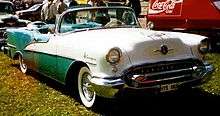
The name was then used for the 1954–1956 model years to designate the convertible models of the 98 line in much the same way that the Holiday name was used to designate hardtop body-styles. The 1954–1956 Oldsmobile 98 Starfire convertibles were the most expensive Oldsmobiles offered during those years. During the 1957 model year, all 98 models were referred to as being Starfire 98s. The name was dropped from the 98 series beginning with the 1958 model year.
First generation (1961–1966)
| First generation | |
|---|---|
.jpg) 1961 Oldsmobile Starfire | |
| Overview | |
| Production | 1960–1966 |
| Model years | 1961–1966 |
| Assembly | Lansing, Michigan, United States |
| Body and chassis | |
| Body style | 2-door convertible 2-door hardtop |
| Layout | Front-engine, rear-wheel-drive |
| Platform | B-body |
| Related | Oldsmobile 98, Oldsmobile Jetstar I, Oldsmobile 88 |
| Powertrain | |
| Engine | 394 cu in (6.5 L) V8 425 cu in (7.0 L) V8 |
| Transmission | 3-speed automatic 4-speed manual |
| Dimensions | |
| Wheelbase | 123.0 in (3,124 mm)[2] |
| Length | 212 in (5,385 mm) (1961–63) 215.3 in (5,469 mm) (1964) 217 in (5,512 mm) (1965–66) |
| Width | 78 in (1,981 mm)[2] |
| Height | 54.7 in (1,389 mm)[3] |
| Curb weight | 4,305–4,492 lb (1,953–2,038 kg) |
| Chronology | |
| Successor | Oldsmobile Toronado, Oldsmobile Delta 88 Royale, Oldsmobile Delta 88 Custom |
1961

Introduced in January 1961 as a convertible, the Starfire was separated into its own model line and shared its body and wheelbase with the Super 88 and the lower-priced Dynamic 88. It was loaded with standard equipment including leather bucket seats, center console with tachometer[4] and floor shifter for the Hydra-matic transmission, and was the first U.S. full-sized production car to feature an automatic transmission with a console-mounted floor shifter, brushed aluminum side panels and power steering, brakes, windows and driver's seat.[5] With a base price of $4,647 in 1961, it was the most expensive Oldsmobile, even more than the larger Ninety-Eight models. The standard 394 cubic inch V-8 Skyrocket V8 engine - Oldsmobile's most powerful in 1961 - used a 4-barrel Rochester carburetor and generated 330 hp (246 kW) at 4600 rpm. Sales of the 1961 model were 1,500.
1962
.jpg)
For the 1962 model year, the convertible was joined by a two-door hardtop, which featured a new convertible-styled roofline shared with other Oldsmobile 88 coupes. Horsepower was increased to 345 hp (257 kW). 1962 was the best sales year for this generation Starfire, with sales of the hardtop coupe being 34,839 and sales of the convertible being 7,149.[6]
1963
.jpg)
Styling changes for the 1963 model year included a move away from the sculpted sides of the previous years model, to a flatter, more conventional look with an exclusive squared off roofline that included a concave rear window. Sales of the coupe were down to 21,489 and the convertible was down to 4,401,[7] a drop of 38%,[7] probably due to intense competition from Buick's all-new Riviera, which was in the same price range as the Starfire but had its own unique bodyshell. The Pontiac Grand Prix was also restyled for 1963 with a similar squared-off roof, which no doubt stole some sales from Oldsmobile showrooms.
1964
.jpg)
The 1964 model appeared very similar to the 1963. Curb weight was down, but overall length was up to 215.3 inches (5,468.6 mm). Sales dropped further, to 13,753 coupes (down 36%) and 2,410 convertibles (down 45%).[8] The Starfire now shared its basic bodyshell with the new and lower-priced Jetstar I hardtop coupe which competed directly against the Pontiac Grand Prix. The Jetstar also used the Starfire's 345 hp (257 kW) 394 cu in (6.5 l) "Ultra High Compression" Rocket V8, but had a pricetag that was over $500[9] lower than the Starfire due to the use of a vinyl bucket seat interior and the fact that many Starfire standard features were optional on the Jetstar including Hydra-Matic transmission, power steering and brakes. Front seat belts were now standard.[10]
1965
.jpg)
.jpg)
For the 1965 model year, all Oldsmobiles would receive new styling, and the Starfire Coupe would receive a modified version of the 1963–1964 unique roofline with an inversely curved rear window. The Hardtop Sports Coupe body-style was again shared with the Jetstar I. Other 88 models adopted a Holiday Hardtop Coupe body-style that featured more of a fastback roof design, while the Ninety-Eight featured a more squared-off formal roof-line. A new version of the Rocket V8 engine was offered for the 1965 model year, this one measuring 425 cu in (7.0 l) displacement, still using a Rochester 4-barrel carburetor, and generating 375 hp (280 kW) at 4800 rpm. This was still the most powerful engine in the Oldsmobile lineup and used only in the Starfire and the Jetstar I. Also new for 1965 was the three-speed Turbo Hydra-Matic automatic transmission which replaced the previous fluid-coupling Hydra-Matic used by Oldsmobile since 1940. Added to the option list for the first time on Starfires and other B-body cars was a four-speed manual transmission with Hurst shifter that was rarely ordered.
1965 sales were 13,024 for the coupe and 2,236 for the convertible.[11]
1966
In 1966 the all-new, front-wheel drive Toronado took the crown from the Starfire as Oldsmobile's premier personal luxury car and most expensive model. Only the Starfire Coupe was offered, as the convertible was discontinued for this final year for the nameplate as a full-sized sporty/luxury coupe. The Starfire was moved downmarket and priced like the former Jetstar I. Equipment level dropped considerably from previous years, with a less plush interior thanks to the leather seats being replaced by Morroceen vinyl for both the Strato bucket seats or no-cost optional notchback bench seat, and no longer standard power windows and power seats. The Turbo Hydra-Matic transmission, power steering and power brakes also went to the optional equipment list; all were standard on Toronado. While the 425 cu.in. V8 still produced 375 hp (280 kW; 380 PS), the Starfire no longer had the most powerful engine offered for sale in an Oldsmobile. Here the Starfire was again upstaged by the Toronado, which had a similar engine offering 385 hp (287 kW; 390 PS). Sales of the 1966 Starfire Coupe were 13,019.[12]
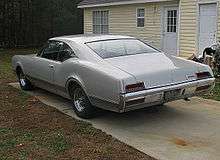
End of the line
For 1967 the Starfire was discontinued, and in its place Oldsmobile offered a new upmarket version of the Delta 88, the Delta 88 Custom. At a $3522 base price,[13] nearly unchanged from the 1966 Starfire, it had similar interior trimmings and even carried the trademark brushed side trim with faux vents on the front fender. The two-door Holiday Coupe hardtop was complemented by a four-door Holiday Sedan, with the notchback bench seat. Later full-sized Oldsmobile coupes to carry on the Starfire tradition included the 1969–1970 Delta 88 Royale and 1978–1981 Delta 88 Holiday Coupe.
Second generation (1975–1980)
| Second generation | |
|---|---|
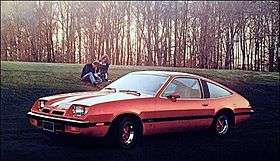 1975 Oldsmobile Starfire SX hatchback coupe | |
| Overview | |
| Production | 1974–1979 |
| Model years | 1975–1980 |
| Assembly | Sainte-Thérèse Assembly- Quebec, Canada Lordstown Assembly- Lordstown, Ohio, United States |
| Body and chassis | |
| Class | Subcompact |
| Body style | 2-door Hatchback |
| Layout | Front-engine, rear-wheel-drive |
| Related | Buick Skyhawk, Pontiac Sunbird, Chevrolet Monza, Pontiac Astre, Chevrolet Vega |
| Powertrain | |
| Engine | 140 cu in (2.3 L) L11 I4 151 cu in (2.5 L) Iron Duke I4 231 cu in (3.8 L) Buick V6 305 cu in (5.0 L) Chevrolet V8 |
| Transmission | 4-speed manual 5-speed T-50 manual 3-speed THM-200 automatic 3-speed THM-250 automatic |
| Dimensions | |
| Wheelbase | 97.0 in (2,464 mm)[4] |
| Length | 179.3 in (4,554 mm) |
| Width | 65.4 in (1,661 mm) |
| Height | 50.2 in (1,275 mm) |
| Curb weight | 2,800 lb (1,300 kg) |
| Chronology | |
| Successor | Oldsmobile Firenza |
The second generation Oldsmobile Starfire is a subcompact four-passenger automobile which was introduced in September 1974, and produced for the 1975 through 1980 model years. The Starfire was Oldsmobile's entry-level product and a badge engineered version of the Chevrolet Monza, which was based on the Chevrolet Vega. The Starfire was virtually identical to the Monza other than Oldsmobile specific badges and the grille design.[14] It would be the smallest car bearing the Oldsmobile name since before World War II. An upgraded SX model was available, and the GT was introduced in mid-1975.[15]
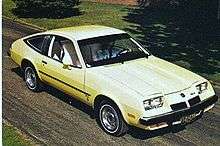
.jpg)

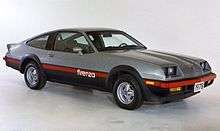
The Starfire has a 97.0-inch (2,460 mm) wheelbase and a 65.4-inch (1,660 mm) width. The Starfire, Chevrolet Monza, Buick Skyhawk and Pontiac Sunbird were among the first vehicles to adopt the newly approved quad rectangular headlamps. The body style is noted for having a resemblance to the Ferrari 365 GTC/4. Starfire's standard engine for 1975-76 model years was the Buick 231 cid V6 engine using a 2-barrel carburetor that generates 110 hp (82 kW) at 4000.
The front suspension is short and long control arms with coil springs, and anti-roll bar; the rear suspension is a torque-arm design with coil springs and an anti-roll bar. The second generation Starfire is a rear-wheel-drive vehicle with a live rear axle design. Variable-ratio power steering was standard of a recirculating ball type. The brake system features standard power assist including front disc brakes with solid rotors, and rear drum brakes. This was the first GM product to incorporate a torque arm rear suspension (rear coil springs with 2 links) - its design was later incorporated into GM's third and fourth generation F-bodies (Camaro and Firebird).
1976 models could be had with the new optional Borg-Warner 5-speed manual with overdrive transmission. Starting with the 1976 models the front disc rotors were of the vented type.[16]
For the 1977 model year, the front end was revised with a split grille design with vertical slots similar to the previous year's Cutlass base models. The 140 CID (2.3-liter) aluminum-block inline 4-cylinder engine with 2-barrel carburetor became standard, while the Buick 231 cid (3.8-liter) V6 became optional on the base model. The GT package included the V6 engine. The Chevrolet 305 (5.0-liter) V8 engine option was added later in the year. The Vega 140 CID aluminum-block L4 was discontinued at the end of the 1977 model year[17]
The 1978 standard engine was Pontiac's 151 CID (2.5-liter) Iron Duke inline 4-cylinder engine with a 2-barrel carburetor, generating 85 hp (63 kW) at 4400 rpm. Late in the year, Oldsmobile added the Starfire Firenza package which included special rallye suspension, a front air dam, rear spoiler, flared wheel openings taking the width to 67 in, sport wheels and special paint and trim.[18]
The 1979 model year saw a face lift, with twin rectangular headlamps replacing the previous quad rectangular headlamp design. The rear end was revised with a blunt rear body panel containing new taillamps and the license plate mounted above a conventional rear bumper. The V8 engine option was dropped at the end of the 1979 model year, as was the 5-speed manual transmission.[19]
The 1980 model year was the last one for the Starfire and its derivatives. Production ceased December 21, 1979, as Oldsmobile traded H-body production to Chevrolet and Pontiac in exchange for a higher allotment of new FWD X-bodies.[20]
The rear-wheel-drive H-body cars including the Starfire were replaced in the spring of 1981 with the new front-wheel drive J-cars designated as early 1982 models, including the Oldsmobile Firenza.
A total 125,188 H-body Starfires were produced in six model years.[21]
See also
- GM H platform (RWD)
- GM 2300 engine
- Chevrolet Vega
References
- Flory, J. "Kelly" Jr. (2008). American Cars, 1946 to 1959; Every Model, Year by Year. McFarland & Company, Inc., Publishers. p. 833. ISBN 978-0-7864-3229-5.
- "Directory Index: Oldsmobile/1964 Oldsmobile/album_001". Oldcarbrochures.com. Archived from the original on 2013-01-31. Retrieved 2011-11-20.
- http://www.oldcarbrochures.com/static/NA/Oldsmobile/1962%20Oldsmobile/1962_Oldsmobile_Full_Line_Brochure/1962%20Oldsmobile%20Full%20Line-30.html
- Gunnell, John A. (ed.). Standard Catalog of American Cars 1946-1975. krause publications. ISBN 0-87341-027-0.
- "Archived copy". Archived from the original on 2012-01-25. Retrieved 2012-06-23.CS1 maint: archived copy as title (link)
- Flory, J. "Kelly", Jr. American Cars 1960-1972 (Jefferson, NC: McFarland & Coy, 2004), p.183.
- Flory, p.249.
- Flory, p.318.
- Flory, pp.316 & 318.
- http://www.oldcarbrochures.com/static/NA/Oldsmobile/1964%20Oldsmobile/1964_Oldsmobile_Prestige_Brochure/1964%20Oldsmobile%20Prestige-34-35.html
- Flory, p.389.
- Flory, p.467.
- Flory, p.542.
- h-body.org
- 1975 Starfire brochure
- 1976 Starfire brochure
- 1977 Starfire brochure
- 1978 Starfire brochure
- 1979 Starfire brochure
- Ward's Automotive Yearbook 1980. Ward's Communications, Inc. 1980.
- H-Body.org
Sources
- Flammang, James M. & Kowlake, Ron, Standard Catalog of American Cars: 1976-199, 3rd Edition (Iola, WI: Krause Publications, 1999)
- Gunnell, John, Standard Catalog of American Cars: 1946-1975, Revised 4th Edition (Iola, WI: Krause Publications, 2002)